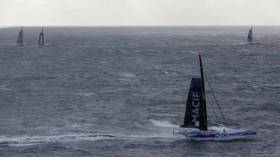Displaying items by tag: Brest Atlantiques
Brest Atlantiques Race for Ultim Class Begins in Strong Winds
The Brest Atlantiques offshore race officially started today, Tuesday 5th November, at 11 am, in front of the Chaussée de Sein in Brest, western France. The four trimarans of the Ultim 32/23 class set off at more than 30 knots of speed, with a north-westerly wind of about thirty knots and in a heavy sea with waves 4.5 metres high.
Trimaran Macif (François Gabart / Gwénolé Gahinet) was the first to cross the line, and shifted slightly northwards ahead of the three other competitors: Actual Leader (Yves Le Blevec / Alex Pella), Maxi Edmond de Rothschild (Franck Cammas / Charles Caudrelier) and Sodebo Ultim 3 (Thomas Coville / Jean-Luc Nélias), who were all at the southern end of the 2.5-mile line. On the first day out at sea, the descent down into the Bay of Biscay was fast, with heavy waves which should however gradually die down. They should cross Cape Finisterre, at the north-western tip of Spain, after about ten hours.
 The Brest Atlantique course
The Brest Atlantique course
QUOTES – The final words from the sailors before leaving the dock in Brest early this morning:
François Gabart (Trimaran Macif): "We're going to have to be careful in the Bay of Biscay with some tough conditions, but it's good to reach the trade wind quickly. We have to find the right pace from the start for the boat and for us. During the first few hours, we will always have one of us listening and not far from the helm to try to go fast without forcing the boat. A priori, there will not be many manoeuvres, it will be mostly piloting. »
Thomas Coville (Sodebo Ultim 3): "The first day in the Bay of Biscay will be very busy, you have to be very concentrated straight away; there can be no mistakes, it will take a lot of energy from the start. I can see what is at stake in these first few hours of racing, it's not insignificant, but I don't have any particular worries. We have to pass this Bay of Biscay fairly quickly, after that it's going to be an absolutely fabulous ride to Brazil. »
Franck Cammas (Maxi Edmond de Rothschild): "The start will be windy and tonight it will calm down, so we’ll go fast tonight! Until then, we'll try to be careful, to get out unharmed in Cape Finisterre, there's no point in attacking from the start, we're only at the beginning of the race. We can do more tomorrow morning when we're already south enough! »
Yves Le Blevec (Actual Leader): "The start days are always important moments, we are feeling confident, it's finally time to sail! The first ten hours will be cautious, it will be necessary to balance the need for speed and competition with that of being safe.





























































